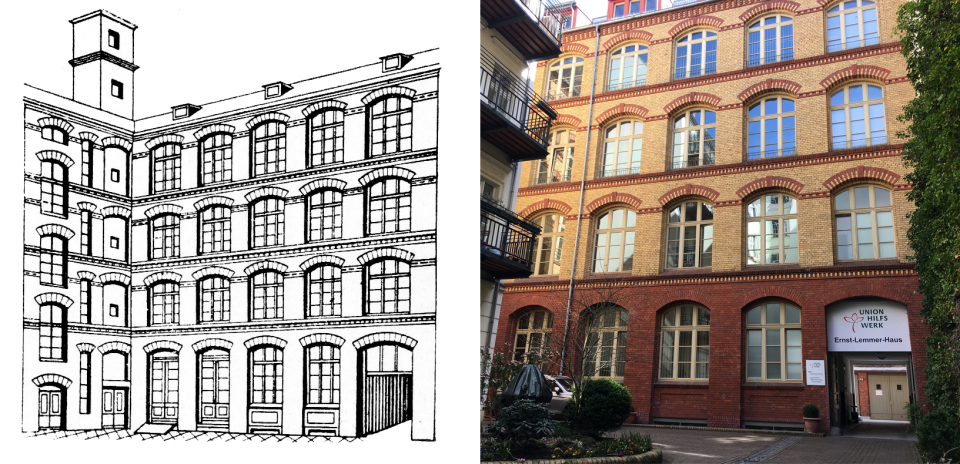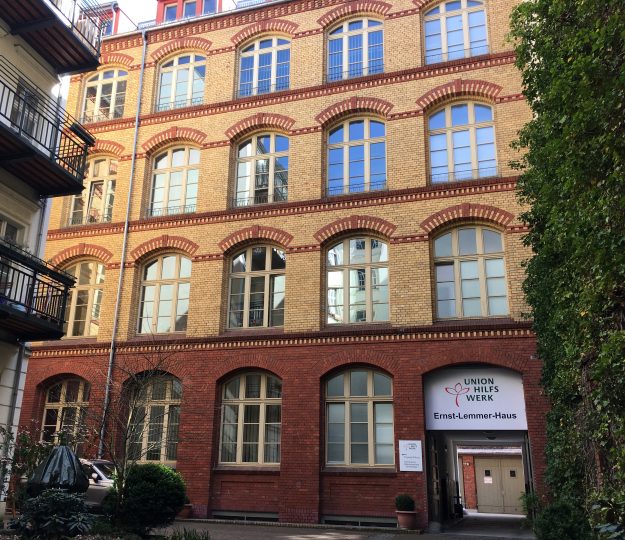The image above reproduces two views of the building that housed the Norddeutsche Schriftgießerei from 1926/1927 to 1960/1961. The illustration on the left appeared in Die Handsatzletter (issue 8, 1975, p. 6). I took the photograph on the right in 2018.
This post is a 2,400-word look into another Berlin typefoundry building that has survived into the present day. At the same time, this third entry in my series on Berlin foundries and their buildings discusses the relationship the Norddeutsche Schriftgießerei came to have with VEB Typoart, the state-owned typefoundry in the former East Germany. Type and typography from the German Democratic Republic’s history has been a procrastiworking research-pastime of mine since early 2011. Although I have presented on aspects of those topics at a few conferences, I have not published very much about them to date. This post is my second foray into that topic on this site. If you like it, check out my earlier post about the life of Otto Erler, a twentieth-century punchcutter from Leipzig.
Introduction
The rear courtyard building pictured above is located in Berlin’s Friedrichshain district. Between 1926 and 1982, it housed several peripheral elements from Germany’s typefounding network. This Richard-Sorge-Straße 21A building, behind Richard-Sorge-Straße 22, was constructed in 1896/1897 by Gaedicke und Wagenknecht for Hugo Lehmann, based on plans by the architect Reinhard Brehm. According to Die Handsatzletter, Heft 8, 1975, p. 6–7, it was heavily damaged during the Second World War. I assume that it was subsequently rebuilt in its original style. After 1997, Richard-Sorge-Straße 21A was given the name Ernst-Lemmer-Haus, after the founder of the Unionhilfswerk Gesellschaft, which now occupies the building. The Ernst-Lemmer-Haus is a protected landmark.
Friedrichshain was one of the Berlin city districts that fell into the Soviet zone of occupation in 1945, and which was part of the German Democratic Republic (GDR) from 1949 until 1990; it was in East Berlin. When this factory building went up back in the 1890s, the street it is on was named Tilsiter Straße. In 1969, Tilsiter Straße was renamed Richard-Sorge-Straße, after a German communist martyr. When the Norddeutsche Schriftgießerei [North-German Typefoundry] moved into the building in 1926/1927, the whole ensemble’s address was Tilsiter Straße 22. In 1960, the Norddeutsche Schriftgießerei was expropriated; thereafter, the building housed VEB Typoart’s Berlin production facilities.
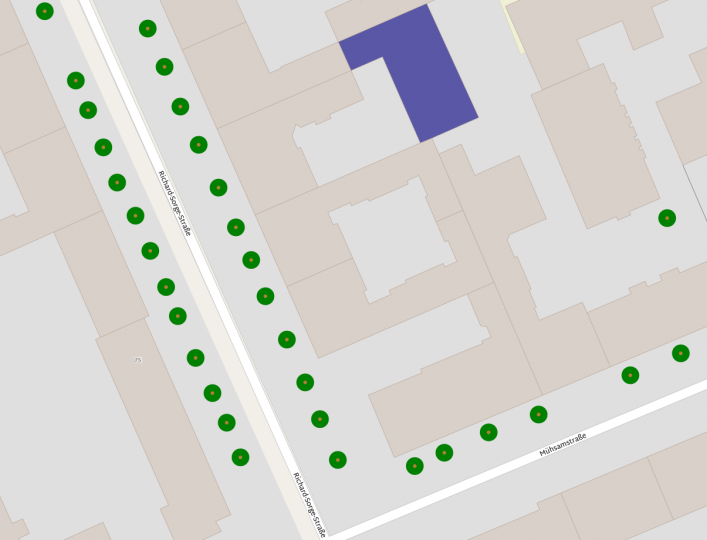
On the above areal plan of the buildings to the northeast of the Richard-Sorge-Straße/Mühsamstraße intersection in Berlin-Friedrichshain, I have highlighted the Ernst-Lemmer-Haus in purple. This was the structure that housed the Norddeutsche Schriftgießerei from 1926/1927 to 1960/1961, and VEB Typoart’s Berlin production facility from 1960/1961 until 1982. © OpenStreetMap contributors.
The building at Richard-Sorge-Straße 21A was not constructed with a typefoundry in mind. It is smaller than the factories that had been purpose-built as typefoundries at the end of the nineteenth century by e.g., Berthold and Gursch. The Norddeutsche Schriftgießerei was a smaller company than either of those firms. A 1975 history brochure printed by the Lettern-Service Ingolstadt stated that the Norddeutsche Schriftgießerei had employed about 150 individuals [see Die Handsatzletter, Heft 8, 1975, p. 6]. Nevertheless, the foundry operated for about forty years, and the brochure is not specific about when – or for how long – it employed that many workers.
In the early 1950s, East Germany gradually hardened its border with the West German states of Bavaria, Hesse, Lower Saxony, and Schleswig-Holstein – but a soft border with West Berlin was maintained until August 1961. Before the Berlin Wall was erected on the 13th of August of that year, East German citizens could freely travel to East Berlin, and then cross the border into West Berlin. From there, they could get to West Germany proper, escaping the East German system. By 1961, the GDR government had deemed that the number of citizens fleeing the country was so high that the results could potentially be destabilising. With the Berlin Wall, they hoped to close off the potential escape route that West Berlin represented forever.
Sources of type in the GDR
While most of the printers’ type in GDR print shops would have come from VEB Typoart – and while VEB Typoart’s types may have been the only conceivable choices for many applications – the state’s “people’s own” typefoundry was never the only source of type in the country. The other types that would have been available changed from decade to decade, but especially during the 1940s and 1950s, some printers would still have had stocks of pre-war types from other typefoundries in their cases. Printers could also acquire fonts of type from the two typefoundries that were independent of VEB Typoart until 1960/1961: Ludwig Wagner AG in Leipzig and the Norddeutsche Schriftgießerei in Berlin. Those two firms were actually “related” to each other, which I describe further below.
An even more significant type source were the many pre-war Monotype machines and sets of Monotype matrices that had survived the war. These were used throughout the GDR’s approximately 40-year history. Additionally, new Intertype, Linotype, Ludlow, and Monotype hot-metal typesetting machines could be imported, at least theoretically. Linotype clones manufactured in the USSR could be acquired as well. In fact, linecasting machines were so important to early-GDR printing that one of the tasks undertaken during the late 1940s and early 1950s by VEB Schriftguß Dresden – a VEB Typoart predecessor firm – had been to reverse-engineer the Linotype matrix-making process. This allowed VEB Typoart to make linecasting-machine matrices of their typefaces, which could be used on a range of linecasters made by various manufacturers. Nevertheless, linecasting matrices of “western” typefaces were occasionally imported, too.
After the late 1960s, the GDR imported photo-typesetting machines from Linotype in West Germany, such as the Linotron 505. These could be delivered with standard typefaces, such as Times or Univers, and each of those two typefaces were often used for book typesetting in the GDR, before VEB Typoart began producing phototype matrices to install on those machines. VEB Typoart also made phototype matrices of its typefaces for other “western” photo-typesetting machines, such as Berthold’s Diatype, as well as for Soviet and Eastern Block machines. Although the GDR had its own dry transfer lettering sheet manufacturing firm (called “Typofix”), Letraset sheets were also used by East German designers who gained access to them.
Like the eastern portion of Berlin, both Dresden and Leipzig were in the zone of Germany that was controlled by the Soviet Military Administration after country’s surrender in May 1945. Between July 1945 and August 1948, the large J.G. Schelter & Giesecke typefoundry in Leipzig – which had been founded in 1819 – was expropriated by the state government of Saxony [see Deutsche Schriftgießerein und die künstlerischen Schriften zwischen 1900 und 1930, p. 143–144]. Saxony expropriated the Dresden typefoundry Schriftguß AG (formerly Brüder Butter) in 1948 as well [see “The Brüder Butter typefoundry,” p. 98–99]. These establishments, now state-owned, had their names briefly changed to VEB Buchdruckmaschinenwerk and VEB Schriftguß, respectively. In April 1951, they were merged together, and in October 1951, the resulting concern’s name was changed to “VEB Typoart – Drucktypen, Matrizen, Messinglinien” [see Die Entwicklung des Betriebes Typoart in Daten und Fakten, p. 27–28].
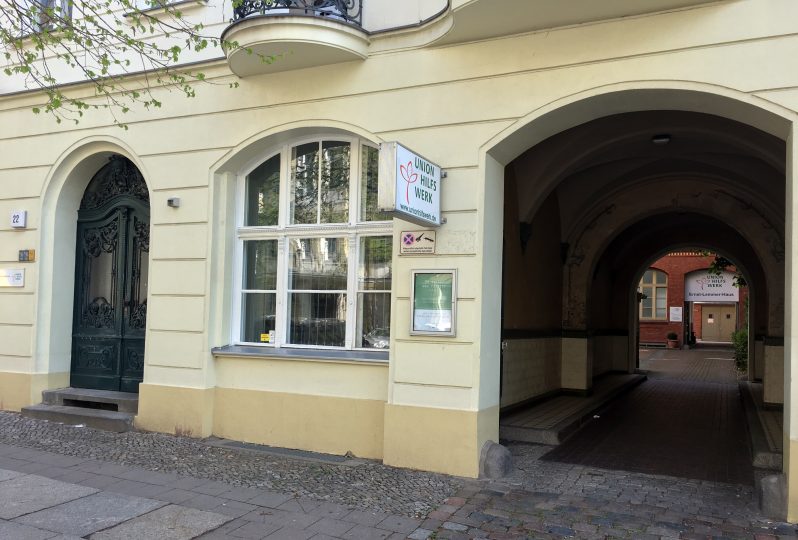
The Ernst-Lemmer-Haus is accessible through a gateway to the right of the entrance to Richard-Sorge-Straße 22. That street-facing building houses residential units. This combination of apartments-in-the-front and factories-in-the-back was a common Berlin city planning solution around the year 1900.
The Norddeutsche Schriftgießerei, its predecessors, and relatives
The Norddeutsche Schriftgießerei began as one of the Wagner family’s typefoundries. Very little information about the Wagner family and its business has been published over the years, at least in comparison with e.g., the businesses of the Bauer and Hartmann families in Frankfurt am Main, Stuttgart, and Barcelona, etc. On the Klingspor Museum’s website, a PDF prepared by Hans Reichardt contains some background for each of the firms, as does Indra Kupferschmid’s presentation on Wagner & Schmidt’s Neue moderne Grotesk, which was recorded at the 2014 ATypI conference in Barcelona. The last business connected with the Wagners’ firms – the Lettern-Service Ingolstadt – was founded in 1965. It remained in business until 2002. In 1975, that firm produced a brochure purporting to celebrate its hundredth anniversary. Yet, as Indra has informed me, Wagner & Schmidt (the very first of the Wagner companies) was not founded in 1875 – as that brochure claimed – but in 1888. The information in the Hans Reichardt’s “Die Firmen der Familie Wagner” PDF is more accurate.
According to that PDF, the punchcutters Ludwig Wagner (1856–1947) and Robert Arthur Schmidt founded the independent Leipzig punchcuttery of Wagner & Schmidt in 1888. An 1888 date for the founding makes more sense to me, too, as Ludwig Wagner would only have been about 19 years old in 1875. Wagner & Schmidt sold matrices of their types to foundries all over Europe. In 1902, Ludwig Wagner left the firm and purchased the Gundelach & Ebersbach foundry, also of Leipzig, which he renamed after himself. Meanwhile, Wagner & Schmidt continued to operate until 1942 [see “Die Firmen der Familie Wagner,” p. 1 and 7].
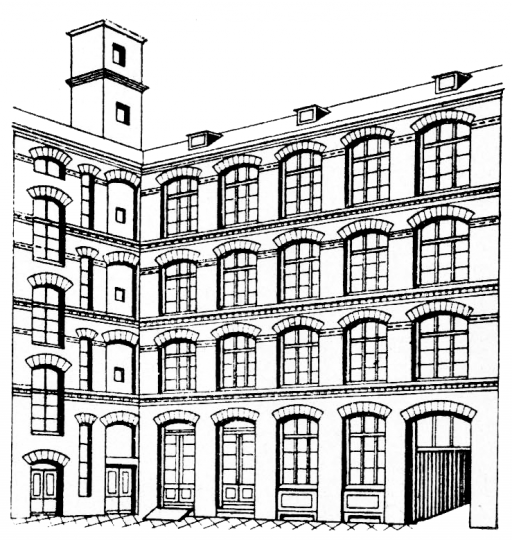
Illustrated view of the Berlin-Friedrichshain building that housed the Norddeutsche Schriftgießerei between 1926/1927 and 1960. Reproduced from Die Handsatzletter (issue 8, 1975, p. 6).
In 1921, two of Ludwig Wagner’s sons and his son-in-law – i.e., Johannes Wagner (1888–1965), Ludwig Wagner jr., and Willy Jahr – founded a typefoundry of their own. They purchased the Steinkamp typefoundry in Berlin and changed its name, thus creating the Norddeutsche Schriftgießerei that is the subject of this post. Johannes Wagner also founded the Johannes Wagner & Co. firm, known by the abbreviation Jowaco, which produced wood type fonts and type shop furniture [see “Die Firmen der Familie Wagner,” p. 11]. The Norddeutsche Schriftgießerei moved into Tilsiter Straße 22 in 1926/1927, and Jowaco went with them, also doing business from that location. Before the Second World War, the Norddeutsche Schriftgießerei had established branch offices in Hamburg (Liliencronstr. 10) and Leipzig (Eckhardstr. 4), too. The matrices for many of its typefaces came from Wagner & Schmidt.
In his “Nachtrag L” PDF, Hans Reichardt reports that Ludwig Wagner jr. was shot by Red Army soldiers on 14 April 1945; he was trying secure typographic matrices, and he died [see “Nachtrag L,” p. 4]. I am not sure where this took place, as the Red Army was not yet in either Berlin or Leipzig by that date. I do not know when Jahr stopped being associated with the Norddeutsche Schriftgießerei, but “Die Firmen der Familie Wagner,” p. 11 implies that the Norddeutsche Schriftgießerei split into two firms at the end of the war: at some point between 1945 and 1949, Johannes Wagner took part of the Norddeutsche Schriftgießerei’s surviving operations, along with what was left of Jowaco – which between 1940 and 1945 had produced armaments – into West Berlin. Meanwhile, a rump Norddeutsche Schriftgießerei continued to operate at the foundry’s original location in East Berlin. From 1945 until 1960, the Norddeutsche Schriftgießerei Mori & Sauer was led by Emil Mori and Maria Sauer (from 1946 through 1952, Berlin telephone books listed the company as the Norddeutsche Schriftgießerei GmbH). While I do not have any biographic information for Sauer, Mori had worked at the Norddeutsche Schriftgießerei since 1928 [see Die Handsatzletter, Heft 8, 1975, p. 6].
Reichardt’s PDFs state that Johannes Wagner moved his West Berlin firm to Ingolstadt in Bavaria in 1949 [see “Die Firmen der Familie Wagner,” p. 14 and “Nachtrag I,” p. 1]. Nevertheless, he still maintained some presence in West Berlin through the 1950s and 1960s; for instance, every West Berlin telephone book until 1972/1973 contained an entry under Johannes Wagner’s name for a Schriftgießerei und Messinglinienfabrik [typefoundry and brass rule manufacturing factory] at Kurfürstenstraße 14 [see Amtliches Fernsprechbuch Ortsnetz Berlin (West), p. 668]. Johannes Wagner himself died seven years before the firm named after him would disappear from the West Berlin phone book.
According to “Die Firmen der Familie Wagner,” p. 7, the older Ludwig Wagner foundry in Leipzig had become an Aktiengesellschaft [joint-stock company] in 1922. In 1943, the Ludwig Wagner AG’s factory was mostly destroyed by Allied bombing. Ownership of the firm’s remains passed to Johannes Wagner in 1948. The foundry received new production facilities in Leipzig in 1949 [see “Entwurf und Herstellung von Schrifttypen in Ostdeutschland,” p. 406 and 412]. Hans Reichardt’s PDFs state that – at least at this point – the Ludwig Wagner AG’s product range was the same as the Norddeutsche Schriftgießerei’s, and that Johannes Wagner moved the headquarters of the Ludwig Wagner business to West Berlin in 1954 and Ingolstadt in 1956, although Ludwig Wagner AG does not appear in any West Berlin phone book. At least some of the Ludwig Wagner AG foundry must have stayed in Leipzig, since Reichardt also states that Johannes Wagner was able to continue to move items from there to Ingolstadt until 1959 [see “Die Firmen der Familie Wagner,” p. 7 and “Nachtrag I,” p. 1]. Ludwig Wagner AG was eventually put under Treuhandverwaltung [trusteeship], and then nationalised outright. In 1961, it subsequently became part of VEB Typoart – just like the Norddeutsche Schriftgießerei had a year earlier.
VEB Typoart Dresden
Typoart’s 1988 history reported that the flight of the Norddeutsche Schriftgießerei’s owner was the reason behind its expropriation in 1960/1961 [see Die Entwicklung des Betriebes Typoart in Daten und Fakten, p. 42 and “Die Firmen der Familie Wagner,” p. 13]. Was that referring to Johannes Wagner, who had been traveling between Ingolstadt in West Germany, West Berlin, and Leipzig in East Germany since at least 1949? Or was this a reference to Emil Mori? In a 9 May 1960 letter on Norddeutsche Schriftgießerei stationery, the firm’s other co-director Maria Sauer wrote that Mori had left the firm on the first of April of that year [see “Die Firmen der Familie Wagner,” p. 13]. Did he retire, or was he one of the many East Germans to flee to the west in 1960, a year before the Wall was built?
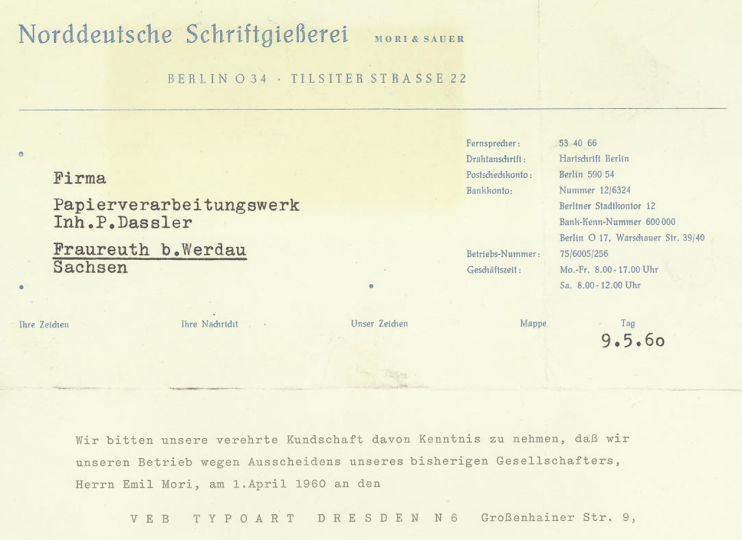
“Die Firmen der Familie Wagner,” p. 13 reproduces a scan of a 9 May 1960 letter from Maria Sauer to a “P. Dassler,” the owner of a paper processing factory in the Saxon town of Fraureuth. In the letter, she explained that the Norddeutsche Schriftgießerei had become part of VEB Typoart; part of that letter is shown above. Even those VEB Typoart used the Norddeutsche Schriftgießerei premises for its own operations in Berlin from 1960 until 1982, the Norddeutsche Schriftgießerei’s remaining product stocks were dismantled and transferred to VEB Typoart, Dresden in 1961 [see“Die Firmen der Familie Wagner,” p. 11].
In 1952 and 1953, the new East German magazine Papier und Druck ran articles on new typefaces produced in the GDR At that time, those articles appeared in the issues’ Typografie und Gebrauchsgrafik sections. The Typografie sections of later Papier und Druck issues from 12/1954, 5/1955, 4/1956, 4/1957, and 3/1960 also included articles about new typefaces; these were usually summaries of the typefaces presented at the typefoundry booths during the annual Bugra trade fairs in Leipzig. In those articles, both VEB Typoart and Ludwig Wagner AG typefaces were discussed, although more editorial space was always given given to VEB Typoart’s products. The Typografie sections in Papier und Druck’s 1958 and 1959 issues did not feature similar articles about new DDR typefaces, but they did still contain multi-page VEB Typoart specimens for e.g., Liberta and Typoart Garamond, as well as a series of profiles of typefoundries from France, Italy, Switzerland, and the USSR. In an article in the 2/1961 issue that described the typefaces presented at that year’s Bugra fair, VEB Typoart was referred to as the “einziger Schrifthersteller der Deutschen Demokratischen Republik” [the only type manufacturer in the GDR] – which, by that time, was what it had become.
Looking through the issues of Papier und Druck from the 1950s, I found no mentions of the Norddeutsche Schriftgießerei. I have no explanation for this. Perhaps the Norddeutsche Schriftgießerei did not produce any new typefaces, and was ignored for that reason. Or they could have been ignored because of connections between the firm and Johannes Wagner’s new businesses in West Berlin and Ingolstadt. Perhaps the Norddeutsche Schriftgießerei did not exhibit at the annual Leipzig fairs at all – unlike Ludwig Wagner AG and VEB Typoart. If the Norddeutsche Schriftgießerei and the Ludwig Wagner AG did have identical product palettes between 1952 and 1960, that could be another reason why only the Leipzig firm (Ludwig Wagner AG) might have been mentioned in the magazine, and exhibited at the fair.
Coda: The five H. Berthold AG employees resident in East Berlin in 1961
Die Entwicklung des Betriebes Typoart, p. 42 includes another result that the building of the Berlin Wall had for the VEB Typoart’s Berlin production facility at Tilsiter Straße 22: until August 1961, five typecasters employed at H. Berthold AG in West Berlin had been living in the eastern part of Berlin. When the Wall was erected, it prevented them from being able to travel to Berthold in West Berlin for work. Stuck inside the GDR, they were given jobs at VEB Typoart. Presumably, they began casting fonts of type inside the factory that – until the year before – had been used by the Norddeutsche Schriftgießerei. Die Entwicklung des Betriebes Typoart did not report about how any of those five individuals felt about this.
Resources cited
- Landesdenkmalamt Berlin: “Obj.-Dok.-Nr. 09085022.” In: Denkmaldatenbank. (Undated).
- Landespostdirektion Berlin: Amtliches Fernsprechbuch Ortsnetz Berlin (West). Branchen-Fernsprechbuch 1. Issue 1971–72. Berlin: Deutsche Post, Bezirksdirektion Berlin (1971).
- Walter Bergner: “Entwurf und Herstellung von Schrifttypen in Ostdeutschland – Zur Geschichte des Betriebes Typoart in Dresden.” In: Mark Lehmstedt and Lothar Poethe (ed.): Leipziger Jahrbuch zur Buchgeschichte 6. Wiesbaden: Verlag Harrassowitz (1996). Pages 405–436.
- Maurice Göldner: “The Brüder Butter typefoundry.” In: Eric Kindel and Paul Luna (ed.): Typography papers 9. London: Hyphen Press (2013). Pages 91–116.
- Kammer der Technik, Fachverband Holz, Papier, Polygrafie (ed.): Papier und Druck – Fachzeitschift. für Typographie, Polygrafische Technik und Papierverarbeitung. Leipzig: Verlag für Buch und Bibliothekswesen; later, Leipzig: Fachbuchverlag; then, Berlin: Verlag Die Wirtschaft (July 1952–June 1991).
- Indra Kupferschmid: How Wagner & Schmidt complicated type history. Lecture at ATypI 2014 Barcelona.
- Lettern-Service Ingolstadt (ed.): 1875–1975 – Einhundert Jahre Wagner-Schriften. Die Handsatzletter. Monografien der modernen Typografie. No. 8. Ingolstadt: Verkaufsabteilung der Firma Johannes Wagner Schriftgießerei und Messinglinienfabrik (1975).
- Hans Reichardt: “Die Firmen der Familie Wagner.” In: Klingspor-Museum. (Undated).
- Hans Reichardt: “Nachtrag I” to Hans Reichardt’s 2011 PDF edition of Friedrich Bauer’s 1928 Chronik der Schriftgießereien in Deutschland und den deutschsprachigen Nachbarländern. In: Klingspor-Museum. (Undated).
- Hans Reichardt: “Nachtrag L” to Hans Reichardt’s 2011 PDF edition of Friedrich Bauer’s 1928 Chronik der Schriftgießereien in Deutschland und den deutschsprachigen Nachbarländern. In: Klingspor-Museum. (Undated).
- SED-Grundorganisation Typoart, Dresden (ed.): Die Entwicklung des Betriebes Typoart in Daten und Fakten – 1945–1985. Herausgegeben aus Anlaß des 40. Jahrestages der Überführung des Betriebes in Volkseigentum am 1. Juli 1988. Dresden: Typoart (1988).
- Dagmar Welle: Deutsche Schriftgießerein und die künstlerischen Schriften zwischen 1900 und 1930. Regensburg: S. Roderer Verlag (1997).
